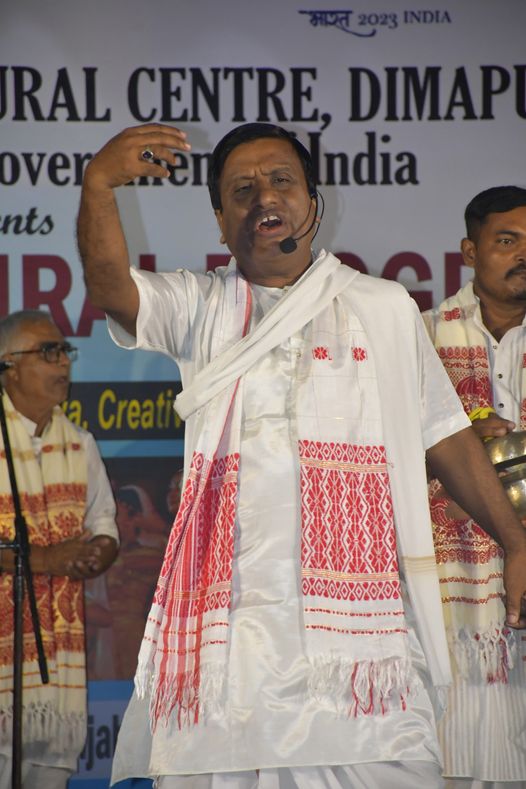HISTORY OF "KALBARI BIRNAM"(NGO)
Sri Sri Ramcharan Thakur cousin of Sri Sri Madhabdeva who was the disciple of Sri Sri Sankardeva established a number of “Satras” in lower Assam after getting the Charge of “Guru”. He made the ‘Satras’ as the religious Centre for popularizing the “Dharma”. Out of there Satras”Kalbari Satra” was one of the famous Satra. The Kalbari Village under Bhawanipur Mouza of Barpeta District abit advanle due to the influence of the Satra. In 1945 in Kalbari village a group for “BirNam”Was formed and under Guru Late Pusparam Pathak the group became a famous “Birnam”group in1985, modifying the traditional “Birnam, Bhortal Nritya, Talar Jamak, Boat Song, Holi Geet,Satriya dance, Angkia Bhaona, Flok songs , Bihu dance were also popular ire after offering proper training. In 1994 Sri Bikul Baishya led the group for a programme at “Assam Cultural Centre at Dhankheti in Shillong (Meghalaya) Satisfying fully respected Biren Borghohain Sir, invited us to different function in Shillong. That period was the first where we performed our programme outside Assam . Respected Borgohain sir had introduced us the then Governor of Meghalaya Mr. Madhukar Dighe, who came to our village in 1995 on 61h.May and enjoyed the cultural programme. Our “Kalbari Birnam” group has been performing in different cultural programmes of the state of Assam and getting a good reputation as well as clinch the first position in different places . In 1995 our “Kalbari Birnam” group was invited to Arunachal Pradesh. Besides we have been performing in Shillong, Tura, Delhi. Guwahati DDK & PPC Doordarsan from time to time. In 2005 Delhi’s Sangeet Natak Akademi (National Academy of Music .Dance and Drama ,India) invited us to perform there Still we have been performing there from time to time . Now Mr.Sushil Kumar Baishya has been serving as the ‘Guru’ and ‘Director’ of “Kalbari Birnam (NGO)”. Under his directions 100 numbers cultural team had performed “Bortaal Dance in the last 33′ National Games in Guwahati in 2007 and get acclaimed . In 2009. this “Kalbari Birnam (NGO) re-organized as NGO.20 th. Numbers cain committee is headed by Mr. Sushil Kumar Baishya as secretary and total numbers of general member are now 100. Now this group has been registered as “Kalbari Birnam”
The following are the different cultural programme that are popularized by us.

Birnam or Thiya Nam
Birnam or Thiya nam standing posture presented by a group of artist in standing posture with clapping and keeping the rhythm in foot. I n Satya yuga , Bali the grand son of Bhakta Prahlad was advised to live in SUTAL PURI by lord Vishnu frequently kept visiting Bali and used to stand before him Seeing Him, Bali used to be extremely delighted and used to keep himself busy in singing the glories of Lord Vishnu along with his fillow Danavas which was named as Veer Nam Later on Mahapurush Sankardeva changed the name and it became popular as Thiya Nam or Birnam in Assam.

Talar Jamak
Nemo enim ipsam voluptatem quia voluptas aspernatur aut odit aut fugitThe songs of this dance form is sung in two tals-the trital and sautal. This dance f or ms celebrates lord Bishnu in all his glory. The dance is accompanied by cymbals and is performed in rhythm with the cymbals. This dance has been created based on the on the Bhortal Nritya . A dancer performing this dance is usually dressed in the beautiful Satriya altire along with various pearls and gems. During the performance of the Talar Jamak a dancer usually ties four cymbals to his body and keeps four cymbals In the ground.

BHORTAL NRITYA
The Bhortal Nritya was created by Narahari Burahbhakat of Barpeta Satra from the Birnarri. Nritya approximately in the year 1950. Apart from Barpeta.this Nritya or dance have succeeded in gaining popularity all over the world. The dancers of this dance use various pearls and also ghungura (anklets) during their presentation. Though this dance was not created by Srimanta Sankaradeva yet it is considered a part of the Satriya culture as it is based on Satriya dance.

HOLI GEET
The Holi Geet or Holi Nam are integral part of Vaishavism. The Holi is celebrated with great pomp and show in Assam along with the rest of India in month Fagun (March). The Holi Nam are a part of Holi celebration. The content of the Holi Nam is that of Lord Krishna playing holi with Gopis. This is very much popular in Barpeta of Assam. NAO KHELOR GEET OR BOAT RACING:- Nau khelor Geet or Boat racing is a part of every country’s culture and tradition at Barpeta of Assam too boat rowing competition are arranged to celebrate the Tirobhav tithis of the Srimanta Sankardeva and Sri Sri Madhavdeva. During these competition the oarsmen sing a type of songs, which have been named as the Nati’ khelor Geet. Based on these songs, stage performance are also presented during various occasions. These song are accompanied by the Nagara and the oars of juri Nau a special type boat.

SATRIYA NRITYA(MATI AKHARA NRITYA)
Towards the end of 15′”.century Mahapurus Sankardeva, the greatest Vaishanavite Saint of Assa created the Satriya dance, which emerged as one of th finest dance form of India.His able disciple Mahapurust Madhavdeva enhanced the classic quality of this dance form during 16′”.century . Mati Akhara is kind of Satriya dance for body fitness. To become a perfect dancer fine body language is very essential. Yogic exercise with some critical pose for dance is highly necessary to perform this Satriya dance .Each Mati akhara is like a letter in an alphabet and if we join together some postures of Mati akhara it gives rise to a beautiful dance sequence .Mati akhara helps to keep one fit for dancing.

Bartal Dance
This dance is performed using the Bartals or big cymbals accompanied by various acrobatic presentations. This form of dance is an offshoot of the Birnam or Thiynam . The trital of the Birnam and chautal of the nagera are used in the performance of this dance form.

Bihu
Denotes a set of three different cultural festivals of Assam & celebrated by the Assamese diaspora around the world is Bihu a celebration that is related to the Crop cycle. It is the counterpart Of what’s called Vaisakhi in Punjab and Vishu in Kerala. Bihu is also Used to imply Bihu dance otherwise called Bihu Naas and Bihu folk songs also called Bihu Geet There are three Bihu celebrations depending on the crop cycle timing. The Rongali Bihu or the Bohag Bihu is an important festival of Assam. It marks as the beginning of an Assamese new year: The Bhogali Bihu or the Magh Bihu is the One that-is all about food. The Kangali Bihu or the Kati Bihu is the third one. The most -important festivals of Assam are the Bihus, celebrated with fun in abundance by all Assamese people irrespective of caste, creed, and belief. In Assam, Rongali Bihu draws from many different traditions Austro-Asiatic, Sino-Burmese and Indo-Aryan— and is celebrated with great fervor. Celebrations begin in the middle of April and generally continue for a month. This is the traditional new year. In addition there are two other Bihus: Kongali Bihu in October (associated with the September equinox) and Bhogali Bihu in January (associated with the January solstice). Like some other Indian festivals. Bihu (ail three) is associated with farming; as the traditional Assarnese society) is predominantly agricultural. In fact, similar festivals are also celebrated around fhe same time elsewhere in India. Bihu is also Celebrated overseas by the Assamese community living in different countries around the globe.
MAIN AIM OF "KALBARI BIRNAM"
The main aim is to popularize the different cultural aspect of Sri Sri Sankardeva and” Lok Sangeet”(Folk song) both in the country and abroad, offering training and preserving the cultural gems. In the first phase we are doing 8 Numbers of programme such as Doordarsan , Director of cultural of Assam, Srimanta Sankardeva Kalakhetra ,Guwahati, Sangeet Natak Academy ,Guwahati and through private institutions. Secondly arrangement for training has been done, various training camp has been arranged. In Tinsukia Centre of Tinsukia District training for Birnam, Holi geet,Bhortal Nritya and “Prasanga Pranali ” has been given and dramatis it by Mrs Bidyawati Phukan(NSD) as “Bol Senai taloike”. Even in Kako Pathar camp under Tinsukia has been arranged to provide training . We are planning to impart training at Srimanta Sankardeva Kalakhetra, Guwahati of the Bhortal Nritya and Birnam. In different parts of Barpeta District also we are planning for training camp on Birnam Bhortal and Nao Khelar geet. Thirdly to preserve the cultural gems a DVD has been prepared in our 8th cultural institution.

